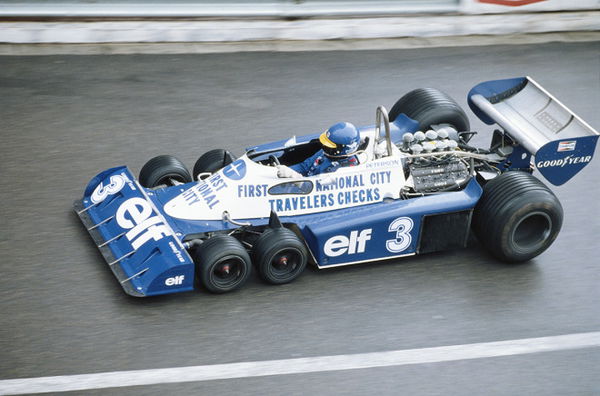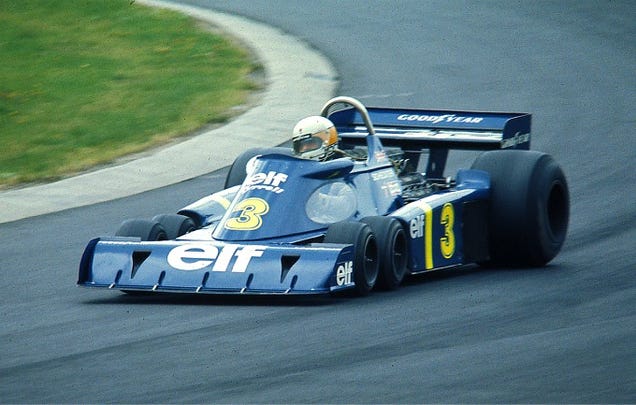When Ideas Ruled F1: Six Wheel Tyrrell

Follow Us

via Getty
Ronnie Peterson drives the #3 Elf Team Tyrrell Ford P34 six wheeler during practice for the Grand Prix of Monaco on 21 May 1977 on the streets of the Principality of Monaco in Monte Carlo, Monaco. (Photo by Tony Duffy/Getty Images)
Modern era Formula 1 is known for its tight regulations but there was a time when the most radical ideas were directly implemented on the tarmac. 1970’s was not only known for Niki Lauda but also for one of the most different ideas in Formula 1 history: A six wheel Tyrrell F1 car.

The Tyrrell P34 also known as “Project 34” was a Formula One race car designed by Derek Gardner, Tyrrell’s chief designer. It was car designer Gardner who first came up with the idea, when trying to figure out a way to make IndyCAR machineries more drivable in the Gas Turbine era (the late 1960s). His innovative thinking led to the idea of fitting your regular racing car with 4 wheels in the front, in order to improve the car’s stability when pushing the gas pedal.
ADVERTISEMENT
Article continues below this ad

The theory behind the P34 was having four 10-inch wheels at the front of the car, with two standard F1 tires at the back, would increase the contact patches of rubber on the road, providing greater traction for turning and braking. The smaller wheels also made for better aerodynamics. There was another popular theory, centering around the elimination of drag by reducing front-tyre size, but that theory is not quite up to scratch, since the freed airflow only went as far as the huge rear tyres. With the buff nose almost completely hiding the front tyres it did however mean that Gardner designed an aerodynamically more efficient machine. He thus increased front-end grip and at the same time reduced front-end drag.
Those four small tires had their highs, but they caused a bunch of problems as well. Firstly, they rotated 1.6 times more than the larger rear tires did over the same distance, so they wore out quickly, significantly hindering performance. The faster spinning wheels also forced the brakes to work harder, which constantly overheated as a result. Throw in some engine and suspension problems, and the six wheel Tyrrell notched eight early retirements to go along with its 10 top three finishes.
The six wheel Tyrrell P34’s golden moment came in the Swedish Grand Prix. Scheckter and Depailler finished first and second, and to date Scheckter is the only driver ever to win a race in a six-wheeled car. He left the team at the end of the season, insisting that the six-wheeler was “a piece of junk!”
ADVERTISEMENT
Article continues below this ad
In 1977, the team redesigned the P34. In an aim to improve aerodynamics the car, it was now wider and heavier than before thanks to some changes to the body. The car was totally unreliable as its brake and tire problems hadn’t been solved. On the year, it managed just 4 podium finishes to go with 19 retirements. To make things worse, Goodyear, which at the time supplied tires for the sport, put more research time and dollars into improving the larger tires used by the rest of the field. The 10-inchers didn’t get better with time, so they were soon left behind. It was clear the car was not as good as before, mostly due to the tyre manufacturer’s failure to properly develop the small front tyres. The added weight of the front suspension system is also cited as a reason for ending the project. Thus, the P34 was abandoned for 1978.

While the six wheel Tyrrell P34 is the only F1 car of its kind to race, there were others too. The March Engineering, Williams and Scuderia Ferrari teams also built experimental six-wheeled F1 chassis, however all of these had four wheels at the back rather than at the front like the P34. The Ferrari 312T6 featured the four rear wheels on a single axle. Despite extensive testing, neither the March, Williams, nor the Ferrari, were ever raced. In 1983 the FIA prohibited cars with four driven wheels from competing. Later, the Formula 1 regulations required four as the maximum number of wheels allowed.
ADVERTISEMENT
Article continues below this ad
Though the idea was not successful, it was one of the unique inventions that motorsports have ever seen. All thanks to Derek Gardner.
Written by:
